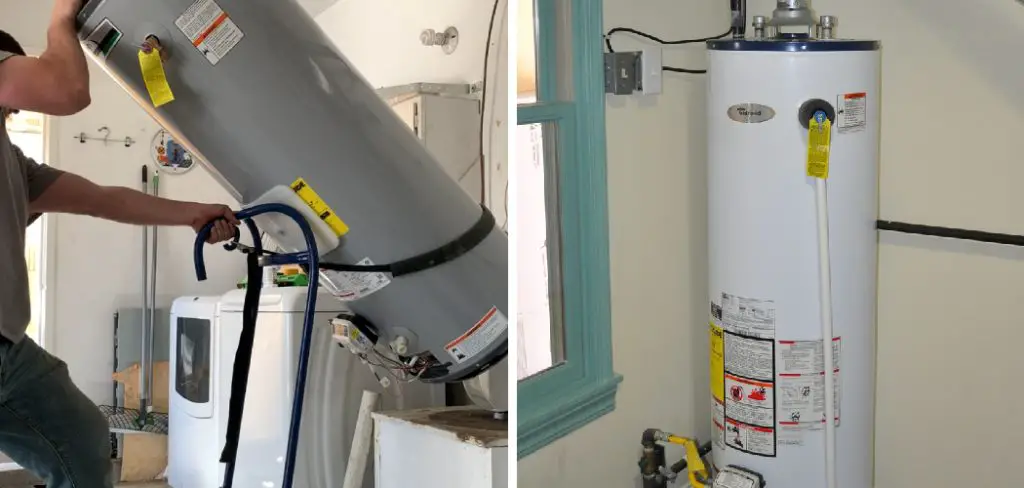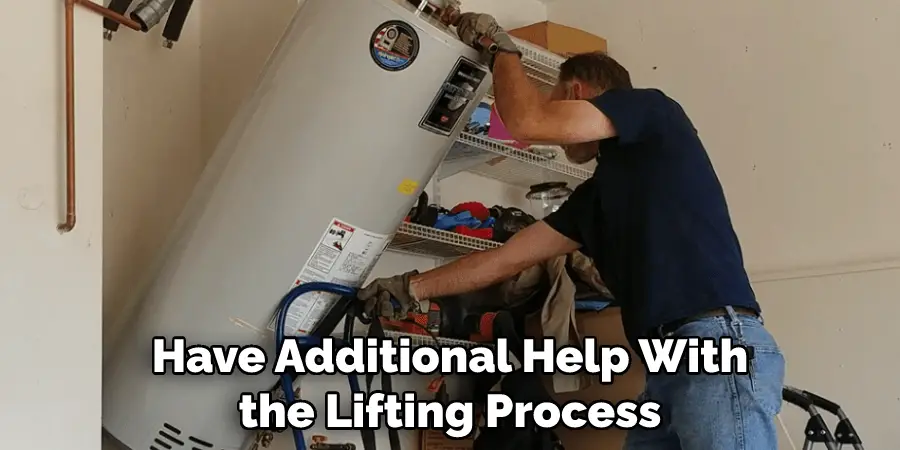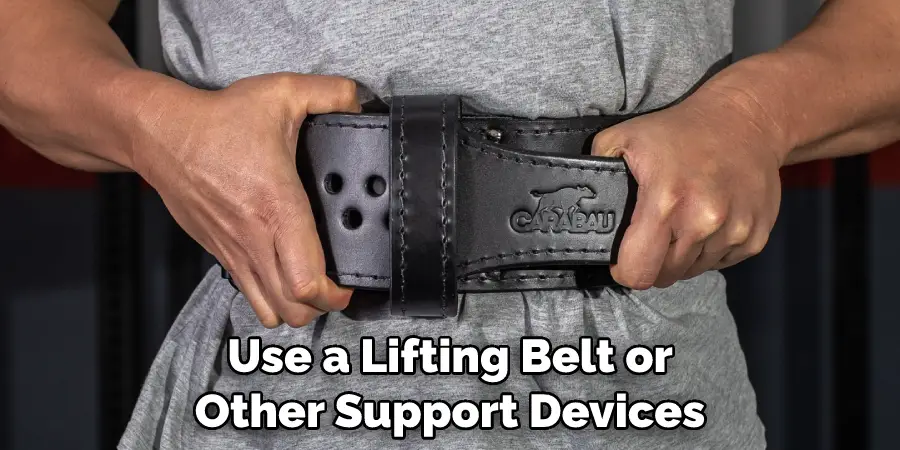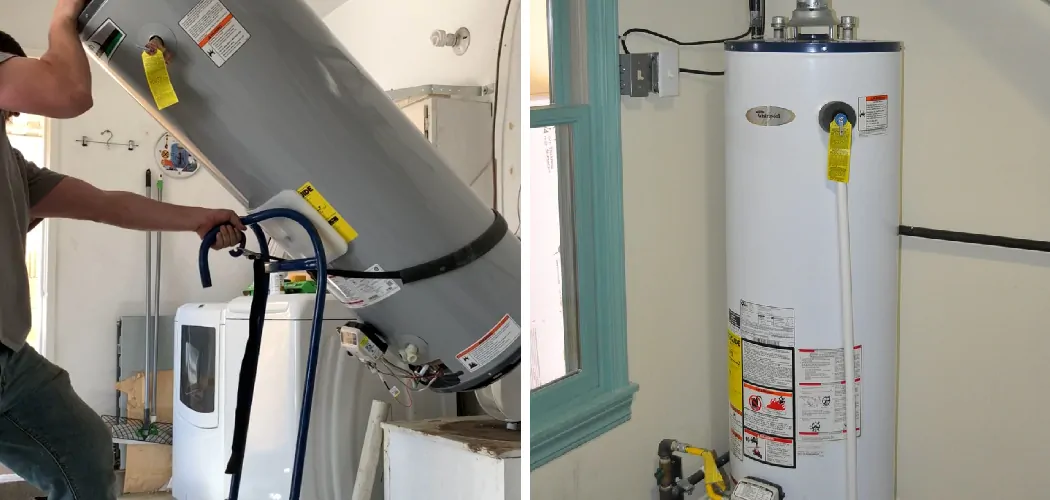Are you looking to replace or move your water heater? Doing so can be daunting, but lifting a water heater with the right tools and techniques is relatively straightforward.
Lifting a water heater may sound intimidating, but it can be done safely with the right equipment and technique. Whether you’re replacing an old water heater or installing a brand new one, the process of lifting one is no different than any other large item. It takes time, patience, and planning to lift your water heater securely, but it isn’t impossible – no matter how hefty it is!

In this blog post, I will provide some useful tips on how to lift a water heater while avoiding injury or damage. Whether you are hoping to move your existing unit or install a new one, my advice should help make it easier for everyone involved!
Why Should You Lift a Water Heater?
Before attempting to lift your water heater, it’s important to understand why you need to do so. Whether you’re replacing an old unit or installing a new one, it’s essential that the job is done safely and securely. If your water heater isn’t lifted properly, there’s a risk of personal injury as well as potential damage to property or the equipment itself.
Lifting a water heater is necessary for many reasons, including:
- Make sure your new unit fits into the space it needs to be installed in
- Moving your existing water heater so that repairs can be made away from its current location
- Ensuring that your new unit will be able to support the weight of how much water it contains
These are just a few reasons why it’s important to lift your water heater properly. With the right knowledge and equipment, lifting a water heater can be done safely and easily!
What Will You Need To Lift a Water Heater?
Here’s a list of some key items that should be used when attempting to lift a water heater:
1. Furniture Sliders or Pads: Using furniture sliders or pads will help protect your floors and make moving the water heater around easier.

2. Straps or Dollies: If your water heater is particularly heavy, it may be necessary to use straps or dollies as well as additional helpers to secure the unit correctly.
3. Safety Glasses: Be sure to wear safety glasses when attempting any type of lifting work just in case anything falls or breaks loose during the process.
These items should all be on hand when attempting to lift a water heater. With the right knowledge and tools, you can ensure that your job goes safely and smoothly!
10 Easy Steps on How To Lift a Water Heater
1. Necessary Knowledge:
Lifting anything heavy requires two people to understand how to do it safely. Ensure each individual knows where their hands will go and how they should be positioned. Don’t forget to wear safety glasses!
2. Prep Your Space:
Remove any furniture, rugs, or other items that may obstruct the lifting process. This will make it easier to move the water heater and prevent any potential damage from happening. Put furniture sliders or pads underneath the unit to protect your floors if needed.
3. Inspect Your Equipment:
Before attempting to lift your water heater, check all straps and sliders to ensure they are secure and in good condition. Make sure everything is properly fastened before you move forward! It’s also important to check for any potential leaks or cracks in your unit that may cause it to become unstable during the moving process.
4. Get Help:
If your water heater is particularly heavy, it’s important to have additional help with the lifting process. The more people involved make for a safer job overall – but only if everyone knows how to lift correctly! Always make sure to have someone spotting the unit during the lifting process in case of any issues.

5. Use Sliders:
Make sure to use furniture sliders or pads underneath the water heater before you attempt to lift it. This will make moving easier and protect your flooring from any potential damage. Otherwise, you may struggle to move the unit due to how heavy it is.
6. Secure Your Straps:
Make sure all straps, dollies, and other equipment are securely fastened around the water heater before attempting to lift it. This will ensure that the unit stays in place during transport. Additionally, it will make it easier for everyone involved to lift without having to worry about the unit slipping or shifting during the process.
7. Lift Carefully:
When lifting, be sure to do so slowly and carefully with both individuals in unison. Ensure each individual’s hands are firmly placed around their designated points on the water heater for secure placement and safe movement.
8. Move Slowly:
When moving the water heater, do so slowly and steadily. This will make it easier to maneuver and also reduce the risk of potential injury or damage. You can also use a dolly or furniture sliders to make this process easier.
9. Set Down Securely:
Once you reach your destination, be sure to set down the water heater securely. Make sure all straps and dollies are removed before doing so for secure placement on the ground. Try to avoid any jostling movements when setting the water heater down.
10. Clean Up:
Last but not least, don’t forget to clean up after yourself! After two people have successfully lifted your water heater, take some time to put away all furniture sliders, pads, and straps used during the process. It is important to remove all items used during the process in order for the next person to use them safely and effectively.
Following these steps should ensure that your job goes smoothly and safely when attempting to lift your water heater. Remember, always wear protective clothing and safety glasses when attempting any lifting work – just in case something were to go wrong! With the right knowledge and tools on how to lift a water heater, you can ensure that the job gets done safely.
5 Additional Tips and Tricks
1. Make sure your feet are firmly planted on the ground before you attempt to lift the water heater.

2. Use a lifting belt or other support devices for lifting heavy items when lifting the water heater.
3. Partner with another person when possible so that they can assist in stabilizing and balancing the weight of the water heater while it is being lifted.
4. Lift slowly and steadily up from your knees, rather than bending over at your waist – this will help prevent back injuries by reducing strain on your lower back muscles.
5. If you feel any pain or discomfort during the process, immediately stop and reassess how you’re lifting the water heater to identify how you can relieve pressure on your body and redistribute the weight.
Whenever lifting a water heater, safety should always be your top priority! Use these tips and tricks whenever you need to move or install a new water heater, to ensure that both you and your investment are protected.
5 Things You Should Avoid
1. Never attempt to lift a water heater alone – it’s too heavy and dangerous. Always have at least one other person helping you lift the device from its location.
2. Avoid lifting the water heater by yourself with the help of a hoist or crane because these tools might not be able to bear the weight of the appliance for long periods of time.
3. Don’t try to move the heaters from side to side, as this could cause them to tip over and damage nearby objects due to their weight and size.
4. Don’t tilt your back when carrying a water heater, even if it is securely wrapped up in blankets or sheets; doing so can lead to serious injury if you lose your grip.
5. Don’t use an open flame near the water heater since this could start a fire if there is any fuel or gas nearby. Be sure to turn off the power from the breaker box before attempting to move it and ensure that no sparks or flames are present.

By following these tips, you can safely lift a water heater without putting yourself or those around you in danger. Remember, safety comes first!
Conclusion
All in all, when lifting a water heater, you have to keep safety a top priority. Make sure that you are using the proper tools and techniques and maintaining a level of caution while working on this project. It is necessary to understand that trying to lift a water heater without any proper equipment can be very dangerous and even potentially fatal. No matter how much experience you may have, there is always some risk involved, so it’s important to take all necessary precautions.
Additionally, if you are not confident enough or your current expertise does not allow you to perform the operation properly, then it’s best for you to consult an expert who will do the work for you. After all, is said and done, though, after having thoroughly read our guide on how to lift a water heater, we hope that nothing but success will come your way while dealing with this issue.
You May Read Also Replace Toilet Water Supply Line

